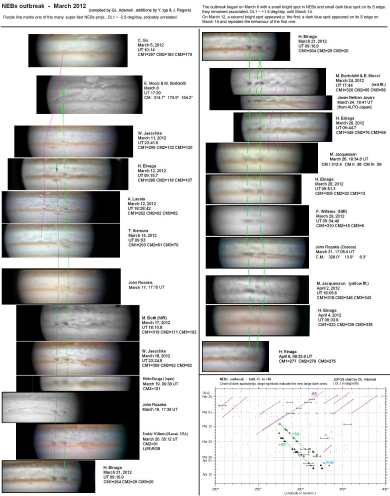
_________________________________
John H. Rogers, Ph.D. Jupiter Section Director,
British Astronomical Association
jhr11@cam.ac.uk
http://www.britastro.org/jupiter/
[5] The NEBs outbreak in 2012 March.
John Rogers & Gianluigi Adamoli (2012 April 9)
Summary:
A striking new outbreak of bright and dark spots has occurred in Jupiter's North Equatorial Belt (NEB). This renewed activity is likely
to develop to an even larger scale, eventually bringing to an end the recent quiescence and narrowing of the belt. Observers are urged to
follow the planet as closely as possible before and after solar conjunction.
Introduction:
Every 3-5 years in recent decades, the NEBn edge has receded, prior to a distinct expansion event, which last happened in 2009. This is often
associated with increased activity of bright rifts in the belt and dark projections on its S edge. (See our 2009 report:)
http://www.britastro.org/jupiter/2009report07.htm
During 2011 the NEBn edge receded, more than it has done in living memory, until the NEB was a remarkably thin dark belt, with the dark
barges left isolated in the NTropZ. Meanwhile all the large dark projections on the NEBs had also
disappeared, being replaced by much smaller ones with a much faster drift - a situation that we have also not witnessed before. By late
2011, everything on the NEBs edge was moving with unprecedented fast speeds of DL1 ~ -75 deg/month, and continuing to accelerate, until by
2012 Feb. the mean speed was DL1 = -83 deg/mth (u = 145 m/s)!
The new outbreak:
On 2012 March 18, Wayne Jaeschke noticed a new outbreak in the NEB, consisting of a bright rift with two very dark spots on the S edge.
The attached compilation shows how the outbreak began and developed. (A similar compilation was kindly sent by Yuichi Iga and some of the
ALPO-Japan images have been used in ours.) The outbreak began on March 8 with a small bright spot in NEBs and
small dark blue-grey spot on its S edge; they remained associated, DL1 = +1.8 deg/day, until March 14. By then the dark blue-grey spot
had become a conspicuous, very dark projection, while the bright spot had expanded into a long rift which moved more slowly. On March 12,
a second bright spot appeared p. the first (at ~9.5 deg.N); a dark blue-grey spot appeared on its S edge on March 14 and repeated the
behaviour of the first one (DL1 = +2.0 deg/day). These two dark spots became intensely dark and large, and remained so
in the latest image on April 6. The leading one retained its identity and drift, although it became quite elongated in the final days of
March, then becoming more compact again. The trailing one became more distorted by the ongoing rifts alongside it, and seems to have
temporarily split into two.
Mean latitudes for the two spots:
7.5 N (+/-0.6) (n=19) March 8 - March 29.
7.7 N (+/-0.5) (n=15) March 14 - April 4.
So far the rifts and the dark NEBs formations have not proliferated further, and the rifts have not intruded northwards. However, this
could well happen in the coming weeks.
Discussion:
The next NEB expansion event could begin at any time. Last time, in 2009, increased rifting in the belt preceded the onset of expansion
of NEBn by several months, and also led to renewal of dark projections on the NEBs. Our working hypothesis is that NEB expansion events
involve the whole belt, much like SEB Revivals [see our 2009 report, link above]. So the present outbreak is probably the start of a complex
process extending over months, which will lead to further outbreaks projecting northwards and initiating the broadening of the belt.
This process could be more impressive than usual in view of the exceptional narrowness and quietness of the belt. The NEB presently
spans latitudes 8-13 deg.N, narrower than at any time since the 1920s. From 1893 to 1915, it regularly shrank to this narrow state or even
narrower, prior to a vigorous outbreak of spots leading to revival every 3 years, much like an SEB Revival [see 'The Giant Planet Jupiter'
chapter 8.5]. Moreover, before 1912, the NEBs edge generally had few or no projections, except during the Revivals, just as in 2011/12.
It is possible that the present state of the NEB represents a return to its behaviour in that era.
Therefore, it will be important and exciting to follow these events. Observers are urged to make the most of the few remaining weeks before
solar conjunction (best for northern hemisphere observers), and to begin observing as soon as possible afterwards (best for tropical
observers).

_________________________________
John H. Rogers, Ph.D. Jupiter Section Director,
British Astronomical Association
jhr11@cam.ac.uk
http://www.britastro.org/jupiter/